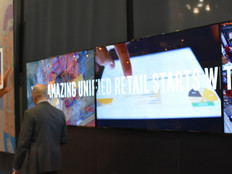For Smaller Retailers, Tech Can Help Them Grow Revenue — and Customer Relationships
The ability to shop on a smartphone and get the exact product you want delivered to your door the next day has upended retail. So has the practice of online comparison shopping and avoiding physical retail stores altogether. However, small and medium-sized retailers see technology not as a threat, but a tool they can use to win back customers’ hearts — and their wallets.
According to a September 2016 report from IDC and sponsored by SAP, 80 percent of SMB retailers (typically those with fewer than 1,000 employees) view changes in their competitive environment positively — as an opportunity, not a risk. “They see successful innovation from start-ups and reinvention,” IDC analysts Raymond Boggs and Greg Girard note.
Further, 33 percent of small and midsize retailers “see advanced technology as an important competitive tool, a strategic resource,” Boggs and Girard say in their report, citing data from IDC’s Worldwide SMB Survey. “When asked a similar question, 38% of larger retailers plan to increase IT spending next year, with a majority citing growth as a key reason.”
SMB Retailers Face Threats from Large Firms, Omni-Channel
Many older SMB retailers started their businesses in radically different technology and competitive settings than they face today, and some have been caught flat-footed, the report notes.
Some SMB retailers, however, are truly innovative, “shaking up retail with new product, category, store, and service concepts — some innovating in staid categories such as home furniture, others creating whole new categories such as athleisure wear, and still more carving out value in convenience such as ready-to-prepare meal subscriptions,” the IDC analysts say.
The IDC report notes that while new, innovative merchandising can be crucially important for smaller retailers, “the greater challenge for many will be leveraging technology in ways that strengthen relations with supply chain partners as well as end customers.”
While smaller retailers can access source products just as easily as large retailers, the report notes that SMB retailers “tend to have a tough time of it as omni-channel commerce challenges one of their basic differentiators — being local.”
“Being able to establish and reinforce a local market presence maintained by strong financials and customer engagement is the sweet spot for most successful small and midsize retailers, but building a local market presence is the aim of successful national chains too,” Boggs and Girard say.
National retailers are “focused on buying, assorting, allocating, replenishing, and pricing to local market conditions such as customer shopping patterns, competitors’ merchandising and marketing tactics, and attributes of large consumer segments.”
As a result, SMB retailers are losing revenue to e-commerce, sales per square feet of store space are declining, and the industry has been hit by bankruptcies and store closures, the report notes.
Using Tech to Stand Out in Retail
SMB retailers’ top business priorities are improving cash flow and revenue growth, and reducing and managing costs, the IDC report notes. However, they see tech as a way to gain ground with competitors.
IDC reports that more 80 percent “don’t view themselves as cautiously investing in new technology. They’d rather take a technology risk than postpone the benefit their investment would yield. Of course, they want benefits most closely linked to their business goals to improve cash flow, accelerate revenue growth, and manage down costs.”
SMB retailers, the report states, are “rapidly gaining experience with and confidence in digital transformation — already 60% have transformed their internal operations with the internet. Success is not rooted in technology but in technology adoption. Half, 50%, invest in technologies to manage costs with efficiency/productivity.”
While only 21 percent of SMB retailers say they are increasingly interested in cloud or hosted solutions, the IDC analysts expect that many more small and midsize retailers will take to the cloud within the next two years.
Indeed, the analysts point out that that “most early-stage small and midsize retailers won’t even consider applications that aren’t cloud-ready and mobile-enabled.” Going forward, they expect that most of the more established SMB retailers will follow suit, “and some will accelerate their refresh cycle to gain these advantages sooner.” Further, “their often limited/constrained financial position will be less of a barrier in taking advantage of superior technology.”
Retailers are now able to use digital technology to gain insight into their sales and customer behavior in ways they never have before, notes Tom Redd, global vice president of strategic communications for SAP Retail.
“For example, the integration of disparate systems and anytime, anywhere access to data on any mobile device are driving new models for consumer engagement and omni-channel commerce,” he writes on SAP’s website. “This connected, mobile approach not only lowers total cost of ownership and accelerates the buying process, but also increases the intelligence and operational flexibility needed to predict emerging demands and evolve processes in response.”
Redd notes that “cloud solutions are also emerging as an easier, faster, cheaper, and more flexible way for retailers to adapt operational capabilities, product inventory, and complementary services to meet expectations throughout the shopping experience. Without investing in more infrastructure, businesses can leverage the latest technology and exchange data company-wide.”
A retailer with a mobile app, in-store beacons and social tools can detect a consumer’s presence in a store or on an e-commerce site, he notes. Then, marketers and merchandisers can “take the information captured from the nuances of consumer shopping behavior and interactions to identify trends, gain insights, and make actionable, outcome-based decisions to personalize e-commerce and in-store experiences to keep customers engaged.”
Redd notes that SMB retailers need to “strike a balance between innovation and consumer expectations.”
“If the shopping experience does not meet expectations or becomes too complex, consumers will run to a competitor,” he says. “The key is finding that middle ground where consumers can shop faster and smarter.”









